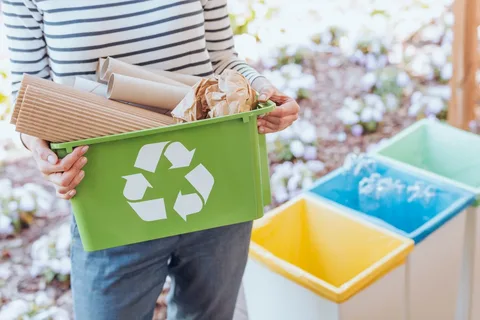A growing awareness of environmental issues and the urgent need to address climate change have propelled the recycling revolution in the United States on a transformative journey. As the nation navigates the green landscape, recycling has become a cornerstone of sustainable living, with individuals, communities, and businesses actively participating in the movement.
Historical Perspectives on Recycling
The roots of recycling in the United States can be traced back to the early 20th century, when World War II prompted large-scale efforts to collect and reuse materials to support the war effort. However, it wasn’t until the environmental movement of the 1960s and 1970s that recycling gained widespread attention. The first Earth Day in 1970 marked a turning point, spurring environmental consciousness and advocacy for sustainable practices.
Government Initiatives and Legislation
Recognizing the importance of recycling in reducing waste and conserving resources, the U.S. government has played a pivotal role in shaping the nation’s recycling landscape. The Resource Conservation and Recovery Act (RCRA) of 1976 provided a regulatory framework for the management of hazardous and non-hazardous waste, laying the groundwork for modern recycling practices. Over the years, subsequent legislation, such as the Clean Air Act and the Clean Water Act, has further emphasized the need for sustainable waste management.
While federal policies set the tone, recycling efforts have largely been driven at the state and local levels. Many states have implemented bottle deposit programs, curbside recycling initiatives, and landfill diversion targets to encourage residents and businesses to recycle.
Challenges in the Recycling Landscape
Despite significant progress, the recycling revolution in the USA faces several challenges. One of the primary issues is contamination, where non-recyclable items are mixed with recyclables, compromising the quality of the materials. Contamination rates vary across regions, and addressing this challenge requires public education, improved recycling infrastructure, and collaboration between communities and waste management entities.

Another obstacle is the market volatility for recycled materials. Global market dynamics have a significant impact on the recycling industry, which affects the demand for and cost of recycled materials. The closure of international markets for recyclables, especially China’s National Sword policy, has disrupted traditional recycling practices, prompting the need for domestic solutions and increased investment in recycling infrastructure.
Innovations in Recycling Technology
Amidst challenges, technological innovations are playing a crucial role in revolutionizing recycling processes. Advanced sorting technologies, such as robotic systems and artificial intelligence, are enhancing the efficiency of material recovery facilities (MRFs), reducing contamination, and improving the quality of recycled materials. These innovations not only streamline recycling operations but also make the process more economically viable.
Furthermore, advancements in recycling technology have led to the development of new materials and products made from recycled content. From recycled PET (rPET) used in beverage bottles to recycled paper and cardboard products, the market is witnessing a surge in eco-friendly alternatives. This not only closes the recycling loop but also creates a demand for recycled materials, fostering a circular economy.
Community engagement and education
The success of the recycling revolution depends on the active participation of communities and the commitment of individuals to adopt sustainable practices. Community engagement and education programs play a vital role in raising awareness about the importance of recycling, proper waste disposal, and reducing single-use plastics. Schools, businesses, and local organizations are increasingly organizing events and campaigns to promote recycling literacy and encourage responsible consumer behavior.
Corporate Responsibility and Sustainable Practices
In addition to grassroots efforts, corporate responsibility has become a driving force in the recycling revolution. Many companies are adopting sustainable practices, incorporating recycled materials into their products, and committing to reducing their environmental footprint. Circular economy principles are gaining traction, emphasizing the need for businesses to minimize waste, maximize resource efficiency, and contribute to the overall well-being of the planet.
Collaborative Partnerships for a Greener Future
The recycling revolution is not solely the responsibility of individuals or businesses; it requires collaborative efforts across sectors. Public-private partnerships are emerging as a key strategy to address recycling challenges comprehensively. Governments, businesses, non-profit organizations, and academia are coming together to share expertise, invest in research and development, and implement holistic solutions that benefit both the environment and the economy.
The Future of Recycling in the USA
As the recycling revolution continues to unfold, the future looks promising but requires sustained efforts and innovations. The USA is witnessing a shift towards a circular economy, where resources are conserved, waste is minimized, and products are designed for recyclability. Advances in recycling technology, coupled with increased public awareness and corporate responsibility, are steering the nation towards a more sustainable and eco-friendly future.
The recycling revolution in the United States represents a dynamic journey towards a greener and more sustainable future. From its historical roots in wartime resource conservation to the contemporary challenges of a globalized recycling industry, the evolution of recycling reflects a collective effort to address environmental concerns and combat climate change. As the nation navigates the green landscape, the synergy of government policies, technological innovations, community engagement, corporate responsibility, and collaborative partnerships is propelling the USA towards a more circular and environmentally conscious future. The Recycling Revolution is not just a movement; it’s a commitment to preserving the planet for future generations.

